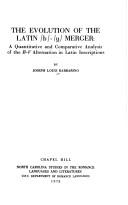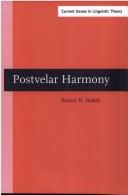| Listing 1 - 10 of 20 | << page >> |
Sort by
|
Book
ISBN: 3111357392 9783111357393 Year: 2017 Publisher: Berlin Boston
Abstract | Keywords | Export | Availability | Bookmark
 Loading...
Loading...Choose an application
- Reference Manager
- EndNote
- RefWorks (Direct export to RefWorks)
Arabic language --- Semitic languages --- Dialects --- Consonants.
Book
ISBN: 9004469737 9004469745 9789004469730 9789004469747 Year: 2022 Publisher: Leiden ; Boston : Brill,
Abstract | Keywords | Export | Availability | Bookmark
 Loading...
Loading...Choose an application
- Reference Manager
- EndNote
- RefWorks (Direct export to RefWorks)
"How can we explain metrical irregularities in Homeric phrases like [androtēta kai ēbēn]? What do such phrases tell us about the antiquity of the epic tradition? And how did doublet forms such as [tetratos] beside [tetartos] originate? In this book, you will find the first systematic and complete account of the syllabic liquids in Ancient Greek. It provides an up-to-date, comprehensive and innovative etymological treatment of material from all dialects, including Mycenaean. A new model of linguistic change in the epic tradition is used to tackle two hotly-debated problems: metrical irregularities in Homer (including muta cum liquida) and the double reflex. The proposed solution has important consequences for Greek dialect classification and the prehistory of Epic language and meter"--
Greek language --- Dialects. --- Consonants. --- Phonology, Historical. --- Variation. --- Language --- Historical & comparative linguistics --- Consonants --- Dialects --- Phonology, Historical
Book

ISBN: 1282716093 9786612716096 3110226588 9783110226584 311022657X 9783110226577 9783110226577 9781282716094 6612716096 Year: 2010 Publisher: Berlin Boston
Abstract | Keywords | Export | Availability | Bookmark
 Loading...
Loading...Choose an application
- Reference Manager
- EndNote
- RefWorks (Direct export to RefWorks)
No sound class requires so much basic knowledge of phonology, acoustics, aerodynamics, and speech production as obstruents (turbulent sounds) do. This book is intended to bridge a gap by introducing the reader to the world of obstruents from a multidisciplinary perspective. It starts with a review of typological processes, continues with various contributions to the phonetics-phonology interface, explains the realization of specific turbulent sounds in endangered languages, and finishes with surveys of obstruents from a sociophonetic, physical and pathological perspective.
Consonants. --- Phonetics. --- Articulatory phonetics --- Orthoepy --- Phonology --- Linguistics --- Speech --- Grammar, Comparative and general --- Phonetics --- Consonants --- Obstruents. --- Phonetics-Phonology Interface. --- Speech Production.

ISBN: 0807892033 1469642859 Year: 1978 Publisher: Chapel Hill University of North Carolina. Department of Romance languages
Abstract | Keywords | Export | Availability | Bookmark
 Loading...
Loading...Choose an application
- Reference Manager
- EndNote
- RefWorks (Direct export to RefWorks)
Classical Latin language --- Grammar --- Inscriptions, Latin --- Latin language --- -Latin language --- -Classical languages --- Italic languages and dialects --- Classical philology --- Latin philology --- Latin inscriptions --- Consonants --- Phonology --- Inscriptions, Latin. --- Consonants. --- Phonology. --- -Consonants --- -Latin inscriptions --- Classical languages
Book
ISBN: 9789027248282 9789027290908 1281042587 9786613773579 9027290903 9027248281 Year: 2010 Publisher: Amsterdam Philadelphia John Benjamins Pub. Co.
Abstract | Keywords | Export | Availability | Bookmark
 Loading...
Loading...Choose an application
- Reference Manager
- EndNote
- RefWorks (Direct export to RefWorks)
This monograph proposes a new interpretation of the intrasegmental structure of consonants and provides the first systematic intra- and cross-linguistic study of consonant prevocalization. The proposed model represents consonants as inherently bigestural and makes strong predictions that are automatically relevant to phonological theory at both the diachronic and synchronic levels, and also to the phonetics of articulatory evolution. It also clearly demonstrates that a wide generalization of the notion of consonant prevocalization provides a uniform account for many well-known processes genera
Consonants. --- Grammar, Comparative and general --- Vowels. --- Consonnes --- Phonologie --- Voyelles --- Phonology. --- Consonants --- Vowels --- Phonetics --- Sonorants (Phonetics) --- Phonology --- E-books --- Linguistics --- Philology --- Grammar, Comparative and general Phonology
Book
ISBN: 9783110568059 9783110565720 9783110565676 9783110568066 3110568063 3110568055 3110565722 3110565676 Year: 2018 Publisher: Berlin Boston
Abstract | Keywords | Export | Availability | Bookmark
 Loading...
Loading...Choose an application
- Reference Manager
- EndNote
- RefWorks (Direct export to RefWorks)
The book analyzes the articulatory motivation of several adaptation processes (place assimilations, blending, coarticulation) involving consecutive consonants in heterosyllabic consonant sequences within the framework of the degree of articulatory constraint model of coarticulation. It also shows that the homorganic relationship between two heterosyllabic consonants contributes to the implementation of manner assimilations, while heterorganicity as well as sonorancy and voicing in the syllable-onset C2 are key factors in the weakening of the syllable-coda C1. Experimental and descriptive evidence is provided with production, phonological and sound change data from several languages, and more especifically with tongue-to-palate contact and lingual configuration data for Catalan consonant sequences. The book also reviews critically research on the c-center effect in tautosyllabic consonant sequences which has been carried out during the last thirty years.
E-books --- Consonants. --- Grammar, Comparative and general --- Phonetics. --- Articulatory phonetics --- Orthoepy --- Phonology --- Linguistics --- Speech --- Phonetics --- Phonology. --- Consonants --- Philology --- Grammar, Comparative and general Phonology --- Assimilation. --- Consonant Clusters. --- Electropalatography. --- Ultrasound.
Book
ISBN: 1614510768 1283856840 1614510776 9781614510765 9781283856843 1614510784 Year: 2012 Publisher: Boston : De Gruyter Mouton,
Abstract | Keywords | Export | Availability | Bookmark
 Loading...
Loading...Choose an application
- Reference Manager
- EndNote
- RefWorks (Direct export to RefWorks)
There is currently a wealth of activity involving the analysis of complex segmental sequences from phonetic, phonological and psycholinguistic perspectives. This volume draws from selected contributions to the conference Consonant Clusters and Structural Complexity held in Munich in August 2008. Consonant sequences, whether occurring within individual lexical items or emerging in running speech at word boundaries, give particularly striking evidence for the temporal complexity of human speech. But contributions also consider the integration of tonal and vocalic elements into syllable structure. The main aim of the volume is to do justice to this complexity by bringing together researchers from a wide range of backgrounds. The book is organized into four main sections entitled 'Phonology and Typology', 'Production: Analysis and Models', 'Acquisition', and 'Assimilation and reduction in connected speech'.
Consonants. --- Grammar, Comparative and general --- Phonetics. --- Articulatory phonetics --- Orthoepy --- Phonology --- Linguistics --- Speech --- Phonetics --- Phonology. --- Consonants --- Philology --- Grammar, Comparative and general Phonology --- Language Acquisition. --- Phonotactics. --- Speech Production. --- Tone. --- Typology.

ISBN: 9027247331 1588112217 9786613312136 1283312131 9027275327 9789027275325 9781283312134 6613312134 9781588112217 9789027247339 Year: 2002 Volume: 225 Publisher: Amsterdam Philadelphia John Benjamins Pub.
Abstract | Keywords | Export | Availability | Bookmark
 Loading...
Loading...Choose an application
- Reference Manager
- EndNote
- RefWorks (Direct export to RefWorks)
This book examines the formal bases of postvelar harmony and its crosslinguistic variation. It is of interest especially to phonologists concerned with segmental harmony and its explanation within Optimality Theory. Postvelar harmony in two unrelated languages, Palestinian Arabic and St'át'imcets Salish, is examined in detail. The result is the first comprehensive clarification of postvelar phonology for either language. Two harmonies are distinguished: uvularisation harmony ('emphasis spread') and pharyngealisation (tongue-root-retraction) harmony. The distinction between these two in th
Grammar, Comparative and general --- Phonetics --- Consonants --- Vowels --- Phonologie --- Phonétique --- Harmonie vocalique --- Consonnes --- Voyelles --- Phonology --- Vowel harmony --- Phonétique --- Phonetics. --- Phonology. --- Consonants. --- Vowels. --- Sonorants (Phonetics) --- Articulatory phonetics --- Orthoepy --- Linguistics --- Speech --- Vowel harmony. --- Philology --- Grammar, Comparative and general Phonology
Book
ISBN: 3484303360 3111847837 3110966069 9783110966060 9783484303362 3484303370 Year: 2012 Volume: 336 Publisher: Tübingen
Abstract | Keywords | Export | Availability | Bookmark
 Loading...
Loading...Choose an application
- Reference Manager
- EndNote
- RefWorks (Direct export to RefWorks)
This book deals with the phonological event of final devoicing in a theoretical framework based on principles and parameters rather than rules. It refers to data coming almost exclusively from German (native and non-native items). The first chapter presents the 'raw facts', providing an outline of the sort of alternations and distributional restrictions on voicing to be accounted for. Previous treatments of final devoicing in German are discussed and evaluated in the second chapter. Chapters 3 and 4 provide an analysis of final devoicing in German couched in the framework of Government Phonology (GP), a phonological theory operating with principles and parameters. Some of the central tenets of GP are introduced at the beginning of chapter 3, and additional concepts of the theory are explained as they become relevant to the discussion of final devoicing. The author argues that final devoicing should be interpreted as a phonological weakening process involving the withdrawal of autosegmental licensing from the laryngeal element L (which represents voicing in obstruents). This occurs in phonologically 'weak' environments, where, due to clearly definable prosodic conditions, only reduced autosegmental licensing potential is available. This analysis, developed with reference to the prestige variety of German (Hochlautung), is then extended to Northern Standard German, and the phonological differences between the two dialects are identified. In the final chapter, the author investigates whether final devoicing results in phonological neutralisation, as is often assumed in the literature. She observes that the GP account developed in chapters 3 and 4 is incompatible with this traditional view. This is desirable, since, among other things, the conflict between earlier phonological analyses and experimental studies of final devoicing can now be resolved.
German language --- Phonology. --- Consonants. --- Ashkenazic German language --- Hochdeutsch --- Judaeo-German language (German) --- Judendeutsch language --- Judeo-German language (German) --- Jüdisch-Deutsch language --- Jüdischdeutsch language --- Germanic languages --- Phonology
Book
ISBN: 1283312417 9786613312419 9027275939 9789027275936 1556198647 9027236534 9789027236531 9781556198649 Year: 1997 Volume: 149 Publisher: Amsterdam Benjamins
Abstract | Keywords | Export | Availability | Bookmark
 Loading...
Loading...Choose an application
- Reference Manager
- EndNote
- RefWorks (Direct export to RefWorks)
This study investigates the phonological behavior of coronal consonants, i.e. sounds produced with the tip or blade of the tongue. The analysis draws on data from over 120 languages and dialects. A definition of coronality is proposed that rejects the current view holding that palatals are positively marked for this feature. The feature [coronal] is assumed to be privative; the natural class of noncoronals is captured with the feature [peripheral], which dominates [labial] and [velar] in feature geometry. The book contains a detailed examination of the phonological patterning of segments belon
Coronals (Phonetics) --- Grammar, Comparative and general --- Phonology --- Coronality (Phonetics) --- Consonants --- Phonology. --- Coronales --- Phonologie --- Phonetics --- Linguistics --- Philology --- Grammar, Comparative and general Phonology
| Listing 1 - 10 of 20 | << page >> |
Sort by
|

 Search
Search Feedback
Feedback About UniCat
About UniCat  Help
Help News
News